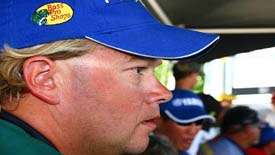
When I think of summertime bass fishing, I'm thinking schools of fish and getting away from the banks. It's a time when I rely on my electronics. Offshore fishing paid big dividends for me last week at the Champion's Choice Elite Series event on Lake Champlain, and it'll work for you, too.
If you're not comfortable working offshore structure and cover, there are some things you can do to improve your skills. The first thing I try to do when I launch my boat on a lake is to keep an eye on my Lowrance electronics. I'm looking for baitfish or bass activity and trying to find the right depth for my day's fishing.
For example, you might see a lot of activity at the 10 to 12 foot range as you cruise the lake. Most of those fish are likely to be suspended and inactive. Don't go chasing them. Instead, take out your map and look for points or creek channels that offer good structure at that same depth. If you can find areas with good structure at that depth, you're one step closer to finding the bass. If you also find good cover there — like rocks or wood — you're almost certainly in the right place.
One of my favorite tools for summertime offshore fishing is a Bomber Fat-Free Shad crankbait. They come in a variety of sizes and colors to reach almost any depth and match just about any situation. My favorite color patterns are shad, chartreuse, citrus shad and chartreuse with a brown back.
I choose the running depth of a crankbait by the depth of water and cover that I'm fishing. I want the bait to run deeper than the bottom so the lure will deflect off cover and get some reaction strikes.
Recently, I've started using Bass Pro Shops XPS Fluorocarbon for my crankbait fishing. It gives me a little more depth than monofilament, and I can pop baits free from cover when they get hung up because it stretches less.
I do my crankbait fishing with an All Star cranking rod that's 7-feet long and has a medium action. It has a good soft tip that allows the bass to really take the bait before I set the hook. I match it up with a Pflueger Trion with a 5.2:1 gear ratio.
Line size, retrieve speed and casting distance all have a lot to do with how deep your crankbait is going to run. Heavy line won't let a bait get as deep as lighter line. A medium to slow retrieve will get your bait deepest, and a long cast gives a lure more time to dive than a short one.
All of this — along with the design and lip size of your crankbait — will determine how deep it gets. You just have to experiment until you find the right mix. Sometimes you'll want to fish a big, deep diving bait fairly shallow, and you can do that by using very heavy line, holding your rod tip up and making shorter casts.
Remember that when you've found one bass on this sort of offshore structure, you've probably found a bunch of them. Keep working the area, and you just might load the boat. It's the best thing about summertime bass fishing.




